The Best Hearing Aids for an Active Lifestyle (Audiologist-Reviewed)

Key Findings
- Jabra Enhance hearing aids are IP68 water-resistant, and they have a 30-hour battery life, making them our top choice for active users.
- Eargo hearing aids are IPX7 water-resistant, allowing them to withstand sweat and humidity. They’re also the most discreet option.
- While not water-resistant, Lexie hearing aids are competitively priced, and they have stellar sound quality.
FYI: Not concerned about durability features? Then read our rundown of this year’s overall best hearing aids.
Why Trust TheSeniorList?
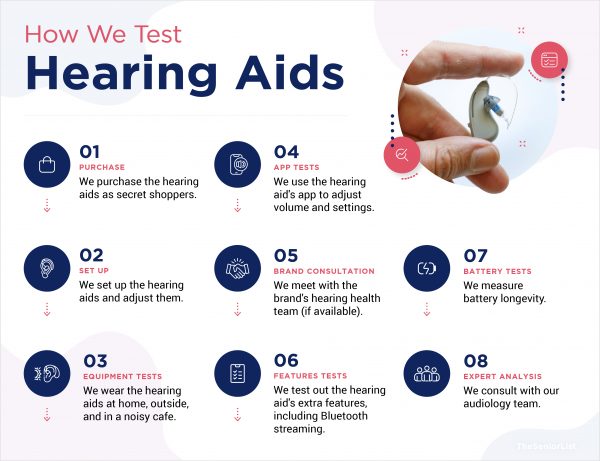
To create this list, we purchased and tested over 20 different hearing aids from 8 brands. We evaluated each device on the following criteria:
- Water and sweat resistance: Moisture can damage devices, particularly for people who exercise while wearing hearing aids, live in a humid climate, or produce a lot of wax. We looked for devices that are resistant to moisture and debris.
- Comfort: We chose hearing aids that fit comfortably in the ear, allowing them to be worn for extended periods of time.
- Long-lasting batteries: We looked into hearing aid brands with long-lasting lithium-ion rechargeable batteries (16 or 30 hours on a full charge). We also focused on hearing aids that can hold a long charge after being charged for just two or three hours.
- Remote support: Getting quality support after your purchase is important for extending the life of your hearing aids. We looked at companies offering superior customer service and free remote support for hearing tests, fittings, and follow-up care with audiologists.
- Warranties: We chose hearing aid companies with two-year or three-year warranties when possible. We also focused on companies that go beyond basic services to offer free cleanings, fittings, and overall hearing aid maintenance.
The Best Hearing Aids for an Active Lifestyle
- Jabra Enhance Select 300 : IP68 water-resistance
- Eargo 6 : Nearly invisible when worn
- Lexie B2 Plus : Low price and Bose hardware
|
Jabra Enhance Select 300
 |
Eargo 6
 |
Lexie B2 Plus
 |
|
|---|---|---|---|
| Rating out of 5 | 4.7 | 4.2 | 4.4 |
| Cost for a pair | $1,795 – $1,995 |
$2,250 |
$999 |
| Warranty | 1 – 3 years |
1 year |
1 year |
| Standout features |
|
|
|

1. Jabra Enhance Select 300 - IP68 water-resistance
 View Packages
Links to Jabra Enhance
View Packages
Links to Jabra Enhance
What We Like Most:
- Personal support from trained audiologists
- Small, lightweight, and easy to wear
- Adjustable settings through the Jabra app
- Dust, water, and sweat resistance

Overview
Cost: $1,795 – $1,995 for a pair
Jabra Enhance Select 300 hearing aids are rated IP68 in terms of water resistance, the highest rating on this list. Whether we wore them on a long run or even in the shower, these hearing aids held up beautifully, and their rechargeable batteries lasted long enough to get us through the day.
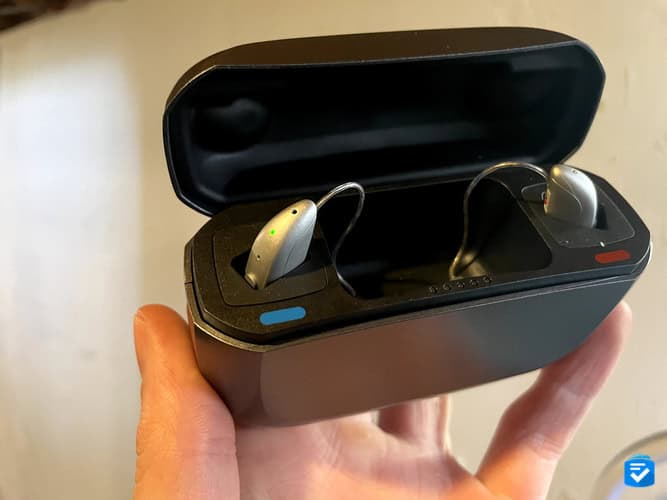
What Stood Out
Compared to other behind-the-ear hearing aids, Jabra Enhance Select 300 hearing aids are impressively small, at 1.14 inches in length. So even though they fit behind one’s ears, they’re pretty discreet. When using our Select 300 hearing aids, we were very impressed by their speech-enhancing capabilities. Whether our team used them in a crowded restaurant or in a quiet conversation, these hearing aids did an exceptional job of reducing background noise and amplifying conversation.
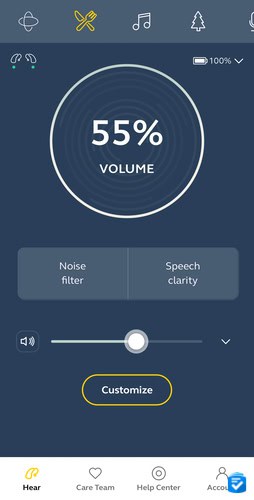
The Jabra Enhance App allowed us to adjust the volume level of our hearing aids, among other settingsAdditionally, through the Jabra Enhance Select mobile app, we could fine-tune the settings on these hearing aids. For example, we could toggle between different hearing environments (All-Around, Restaurant, Music, and Outdoor). We could also fine-tune the volume of specific frequencies. Increasing high-frequency volume, for example, allowed us to hear female voices more effectively.
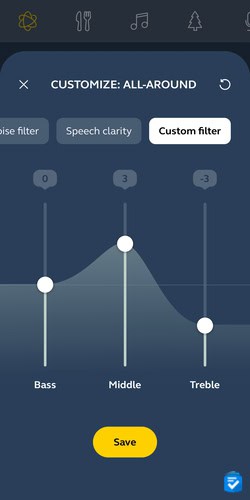
In terms of durability, Jabra Enhance Select 300 hearing aids are rated IP68, meaning they’re dust-resistant, water-resistant, and capable of being submerged in up to 1.5 meters of water for up to 30 minutes. To test this, we dunked the hearing aids in a glass of water. When we pulled them out we noticed no impact on their performance. Elsewhere, when we took them to the gym and rode the spin bike for an hour –– sweating profusely –– we noticed no impact on performance, either.


Pricing
Jabra Enhance Select 300 hearing aids cost $1,795 for the basic package, which includes the hearing aids, the charging case, and a one-year warranty. If, however, you pay $200 extra for the premium package, then you’ll get a three-year warranty plus three years of support from Jabra’s audiology team. We definitely recommend the premium package here, as remote support is essential when purchasing OTC hearing aids.
Jabra also offers two more affordable hearing aid models, starting at $995. These models have the same IP68 durability; however, they lack the advanced sound quality of the Select 300 hearing aids.
To learn about the pricing of these two more affordable models, read our full rundown of Jabra Enhance hearing aid costs.
Drawbacks

While the Jabra Enhance Select 300 hearing aids are smaller than Lexie’s hearing aids, they might be a bit large for users who want something more discreet. Additionally, we don’t like that professional support from hearing specialists costs extra.
Eargo hearing aids, which are practically invisible when worn, include lifetime support from their hearing specialists (more on this below).
Our Verdict
Combining crystal-clear sound quality with durability and nuanced smartphone adjustments, the Jabra Enhance Select 300 is our top hearing aid pick for active users. To learn more about our hands-on experience with these hearing aids, read our full Jabra Enhance review.
Pros
- 30-hour battery life
- High-quality sound
- Ongoing support from hearing professionals
- Easy-to-adjust settings
- Bluetooth compatible
- 100-day return window
Cons
- Professional support costs extra
- Music streaming is low-quality
2. Eargo 6 - Nearly invisible when worn
What We Like Most:
- Rechargeable batteries
- Virtually invisible in-ear models
- Lifetime hearing specialist support
- Smartphone app adjustments
Overview
Cost: $2,250 for a pair
Of all the hearing aids on this list, the Eargo 6 is by far the most discreet. When worn, they sit completely in one’s ear, and they automatically sense the user’s surroundings and adjust accordingly.
>> Read more: Eargo 7 Review
What Stood Out
In terms of design, the Eargo 6 is the clear winner. Not only is this hearing aid the smallest on this list, but it also includes a sleek, compact charging case that can store up to two full recharges. And while the battery life on the Eargo 6 (roughly 16 hours) was slightly shorter than that of Jabra’s hearing aids, it was enough to get us through the day.


The Eargo 6 is rated IPX7 in terms of water-resistance, meaning it can withstand a depth of up to one meter of water for up to 30 minutes. While we wouldn’t recommend wearing these in the pool, they can certainly withstand rain and sweat. When we placed our hearing aids in a glass of water, it didn’t impact their performance.

Our favorite Eargo 6 feature would have to be its automatic sound adjustments. While the other hearing aids on this list allow you to adjust sound settings through smartphone apps –– as do these ones –– with the Eargo 6, you don’t even have to pull out your app for these adjustments to happen. For example, when I walked from the street to a crowded cafe, my hearing aids automatically adjusted to reduce the background noise made by all of the conversations in the cafe.
Pricing
Eargo 6 hearing aids cost $2,250 for a pair. This includes the charging case, a one-year warranty, and lifetime remote support from Eargo’s team of hearing specialists. Since other brands like Jabra require you to pay for support, we appreciated that Eargo included this at no extra charge.
To learn more about the different Eargo models and their costs, read our full rundown of Eargo pricing.
Drawbacks
The most noteworthy drawback of the Eargo 6 (and all other Eargo models) would have to be their lack of streaming capabilities. While Eargo hearing aids do pair with smartphones for remote adjustments, they don’t support the direct streaming of music or calls. For this feature, we’d recommend Jabra Enhance hearing aids.
Our Verdict
To learn more about the company, read our Eargo hearing aids review.
Pros
- Automatic sound adjustments
- Lightweight and comfortable
- Stellar sound quality
- Lifetime hearing specialist support
Cons
- Warranty limited to one year
- No phone call or music streaming
3. Lexie B2 Plus - Low price and Bose hardware
What We Like Most:
- Easy adjustments via Bluetooth
- Hearing aid protection plan
- Under $1,000 for a pair
- Financing available
Overview
Cost: $999 for a pair
While Lexie B2 Plus hearing aids may lack the water-resistance of the other models on this list, their lower price point and stellar sound quality make them worth consideration.
>> Read more: The Best Cheap Hearing Aids
What Stood Out
When we heard that Lexie hearing aids were made with Bose hardware, we naturally had high expectations for their performance. Fortunately, these expectations were met. While wearing our Lexie B2 Plus hearing aids, we found crisp sound quality in a variety of environments. In particular, we noticed that these hearing aids were highly effective in noisy situations, and they routinely drowned out background noise while amplifying conversations.
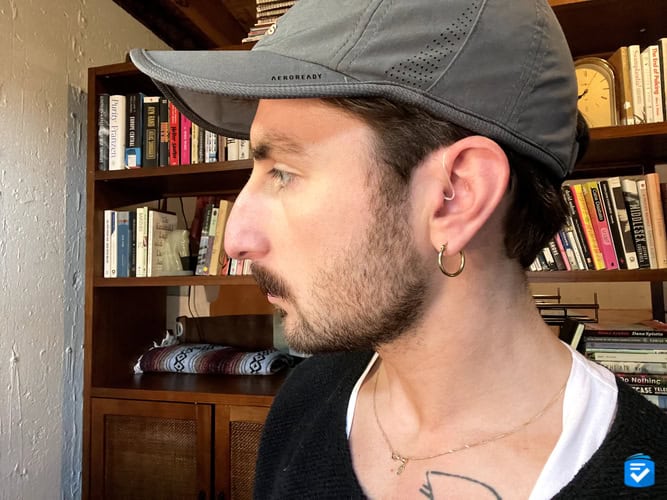
Additionally, after pairing our B2 Plus hearing aids with a smartphone, we were able to adjust them remotely through the Lexie App. Through this app, we could switch through sound environments, fine-tune which frequencies we needed amplify, and even adjust directionality.
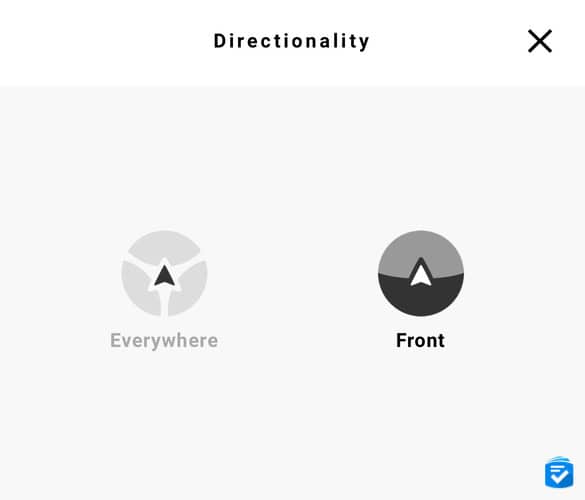
The Lexie B2 Plus was the only hearing aid on this list that allowed us to focus on sounds directly in front of us. This was particularly useful when having conversations in noisy environments.

Pricing
Lexie B2 Plus hearing aids cost $999. This includes the charging case and a one-year warranty. If you want an extended warranty, you can purchase a protection plan for $180, which covers even accidental damage for 24 months.
Drawbacks
While sound quality was superb with the Lexie B2 Plus hearing aids, we were disappointed that these hearing aids didn’t support direct music streaming from smartphones. For a brand that included hardware from Bose, a company known for stellar headphones, we would’ve expected direct music streaming. If you want to listen to music through your hearing aids, then we’d recommend Jabra Enhance.
Our Verdict
While Lexie B2 Plus hearing aids won’t withstand a dunk in water, they perform similarly to the other entries on this list –– all at roughly half the price. To learn more about our experience with these hearing aids, read our full Lexie hearing aids review.
Pros
- Exceptional sound quality
- Phone call streaming for iPhones
- In-app hearing test and adjustments
- Unlimited customer support
Cons
- No music streaming
- No water-resistance
Honorable Mentions
To create this list, we considered over 20 different hearing aid models. Here are some other options worth mentioning:
- MDHearing: While we love MDHearing devices’ low prices, starting at $297 for a pair of hearing aids, they offer little in terms of smartphone compatibility and water-resistance.
- Widex: Known for its high-powered hearing aids fit for severe hearing loss, Widex is one of our favorite brands overall; however, due to the high cost ($3,000 and up for a pair), we wouldn’t recommend taking them out for physical activity.
- Audien: While we appreciated the incredibly low prices of Audien hearing aids, not to mention their availability at Walmart, we found that Audien devices lacked most of the useful features needed to hear in noisy environments.
- Audicus: Audicus hearing aids performed well in our tests; however, none of their models have water-resistance, and only some of them are compatible with smartphones.
How To Protect Hearing Aids While Exercising
You can still protect your hearing aids even if you exercise on a daily basis. It’s important to have a designated dry box to store them, and many hearing aid companies, such as Audicus, even offer an additional UV dry box to keep your hearing aids sanitized.
I also recommend keeping disinfectant wipes handy when you’re on the go. Prevent any earwax buildup or other debris that may get trapped in your hearing aids by using the wax guards or filters that come with your hearing aids. It’s also worth looking into a hearing aid provider’s insurance or protection plans, which may cover unlimited repairs, fittings, and shipments of replacement earwax guards.
Bottom Line
Wearing hearing aids doesn’t have to be uncomfortable when you’re exercising and enjoying an active lifestyle. If you enjoy playing sports or going for frequent jogs, then I’d recommend looking into hearing aids designed to support movement and weather conditions such as rain and intense heat.
To learn more about the best hearing aids, their features, and their costs, check out our guide to the best over-the-counter hearing aids.
Frequently Asked Questions
-
Can you wear hearing aids while exercising?
There are many hearing aids that are moisture-resistant enough to withstand damage during strenuous activities or exercise. It’s perfectly fine to wear your hearing aids while exercising as long as you regularly maintain and clean them.
-
Should you wear your hearing aids every day?
It’s recommended to wear your hearing aids on a daily basis for optimal hearing and for engaging in conversations that would otherwise be difficult without them.
-
Can sweat damage hearing aids?
Sweat, heat, and debris can damage your hearing aids over time. I recommend looking into hearing aids outfitted with a protective nano-coating that’s water-resistant and sweat-resistant.
-
Which style of hearing aid is best for physical activity?
Depending on your hearing loss, completely-in-canal hearing aids are best for physical activity and sports, since they fit directly inside your ear canal and won’t slip out. They also won’t interfere with goggles and other headgear.

